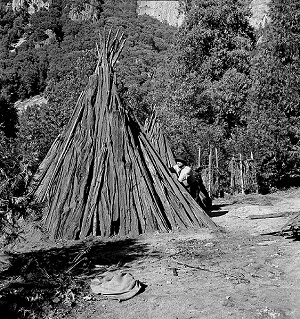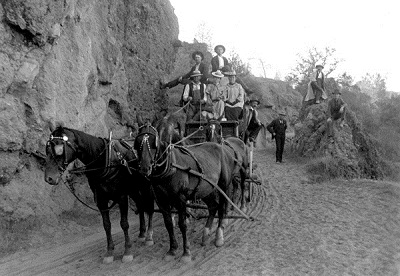History of the BCCER
Pre-Colonial use of the BCCER
Since time immemorial the Mechoopda Indian Tribe has occupied the area known as the BCCER. They utilized a wide variety of naturally occurring resources. While they did not farm in the traditional sense, they were land stewards, enhancing the production of resources by selectively burning and carefully cultivating natural stands of plants while gathering them for food and fiber.
However, by 1900, Native American populations were decimated by diseases of European origin, genocidal wars, and relocation. Communities disappeared, and traditional land stewardship could no longer be maintained.

Historic use of the BCCER
By 1850 persons of European ancestry began to settle the area. They cut timber for their own use and for sale to the developing community of Chico and turned loose cattle, pigs, and sheep to graze. Native wildlife was hunted and trapped for food or sale and to prevent predation on livestock. As more people homesteaded the area, fences were built to separate herds. In the later part of the 19th century, timber in the upper watershed of Big Chico Creek began to be extensively exploited. In 1874 a flume was completed from near Chico Creek headwaters to the town of Chico, passing through the area of the BCCER. This flume included flume tender's cabins and a telegraph line. The flume operated until about 1910.
Vast changes in the ecosystem followed the homesteaders and their livestock. Much of the timberland was replaced by brush and the perennial native grasses were replaced by exotic annual grasses and weeds. Gradually the early homestead families sold out to owners of large cattle ranches and left the area. Cattle were generally driven to the high country in summer and back to the home ranch in fall. As pastures deteriorated the ranches were no longer profitable and speculators began to buy up the land for potential development. One reason for setting up the BCCER was to preserve habitat from development.
The Lucas Family
The Lucas family were the first Europeans to homestead within the area that eventually became the Big Chico Ecological Reserve. Paul Lucas, born in Darmstat, Germany on Christmas Day, 1829, immigrated to the U.S. with his parents and settled in Missouri. Driving an ox team from St. Louis, the young Lucas crossed the plains during the California Gold Rush of 1849. Frustrated with the return on his mining endeavors in Butte County, Lucas reassessed the sources of potential wealth. Like many of the more successful pioneers, Lucas discovered that the majority of California’s opportunity derived more from its golden magnetism on men than on the gold itself and entered the cattle industry. Lucas drove his oxen 14 miles east of Chico to unmarked land where he found good grazing and a sufficient water supply in the Big Chico Creek Canyon. With his cattle brand of 24, good character, good cattle, and good work generated Lucas a respected reputation as he supplied Chico with quality beef. By 1850 he was operating a secure ranching operation.
The future Lucas matriarch, Ellen O’Callahan, immigrated to America with her father after her mother died in Ireland . Forsaking their agrarian past, they settled in the tenements of New York City . Ellen eventually left and managed passage across the Panama Isthmus risking malaria and yellow fever and arrived in San Francisco as a mail-order bride in 1865. On June 13, Paul and Ellen wed and together developed one of Butte County ’s more successful ranching operations, governing over 1000 acres.

The Humboldt Road
Under the direction of the politically influential John Bidwell, the Chico and Humboldt Wagon Road Company constructed a road linking the silver mines of the northeast to the Sacramento River . The company developed houses, stables, and watering sites along the roads for pack trains and eventually sold the interest to these sites to others. Paul Lucas’ ranch adjacent to the Humboldt Road and his operations boomed as his business began to supply Susanville and the miners in the Nevada and Idaho territories. Shortly after his sudden death on April 12, 1879 , Paul Lucas’ family acquired the 14 Mile House, one of ten boarding way stations spaced a day’s travel along the Humboldt Road .
Young John “Jack” Lucas, the eldest son of six children, assumed the business of ranching and slaughtering activities. Ellen Lucas and John expanded the operations of the 14 Mile House with her excellent cooking and fresh produce from her orchards and gardens. The success of the 14 Mile House and the ranching operations enriched the family and the Lucases expanded their ranching operations into Little Chico Creek Canyon and Butte Meadows, adding over 2500 acres.
The Lucas family enhanced the social scene in Chico and the Humboldt Ridge areas. In 1907, John Lucas established the prosperous Chico Meat Company on Second Street between Broadway and Main . He became a civic leader in Chico , serving as a trustee for the Chico Canyon School District and four years as the city trustee.
The Railroad
Although the Lucas family contributed to the early pioneering of Butte County, their regional improvements lacked legal standing. In the 1850’s much of Butte County was uncharted and many pioneers did not bother to obtain legal title through the General Land Office.
On November 12, 1864 Congress ordered a survey of the region intending to grant land and resources to the Central Pacific Railroad so that it could establish a line eastward through the Sierra. On July 25, 1866 , Congress granted the CPRR vast tracts, including all of the Lucas improvements, transforming the Lucases into squatters. Fortunately, Ellen was able to purchase the title to her and Paul’s improvements from the CPRR after her husband’s death. Today the Big Chico Creek Ecological Reserve maintains their memory and history.
Recent History of the BCCER
 The Big Chico Creek Ecological Reserve (BCCER) is owned and managed by the Chico State Research Foundation. The BCCER was acquired in two land purchases in 1999 and 2001. Chico State Enterprises, formerly the University Research Foundation, purchased 3,950 acres of land with grant money from the Wildlife Conservation Board, the Packard Foundation, the U.S. Fish and Wildlife Service, the National Fish and Wildlife Foundation, the River Network, and Jack Henning. Part of the purchase agreement included a conservation easement held by the Wildlife Conservation Board and a Memorandum of Understanding with the CA Department of Fish and Game. A Technical Advisory Committee met monthly for two years creating a Master Management Plan for the reserve. Through adaptive management, further details have been added to create supplemental Vegetation Management and Fire Management Plans. Executing these plans on such a large and varied piece of property is challenging, but we set priorities and do what we can as resources become available.
The Big Chico Creek Ecological Reserve (BCCER) is owned and managed by the Chico State Research Foundation. The BCCER was acquired in two land purchases in 1999 and 2001. Chico State Enterprises, formerly the University Research Foundation, purchased 3,950 acres of land with grant money from the Wildlife Conservation Board, the Packard Foundation, the U.S. Fish and Wildlife Service, the National Fish and Wildlife Foundation, the River Network, and Jack Henning. Part of the purchase agreement included a conservation easement held by the Wildlife Conservation Board and a Memorandum of Understanding with the CA Department of Fish and Game. A Technical Advisory Committee met monthly for two years creating a Master Management Plan for the reserve. Through adaptive management, further details have been added to create supplemental Vegetation Management and Fire Management Plans. Executing these plans on such a large and varied piece of property is challenging, but we set priorities and do what we can as resources become available.


